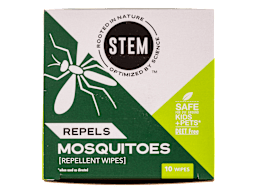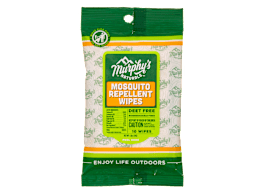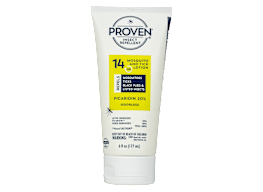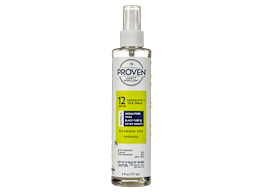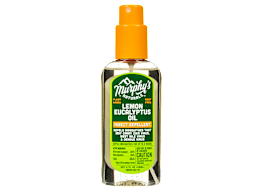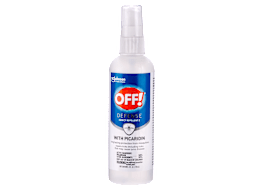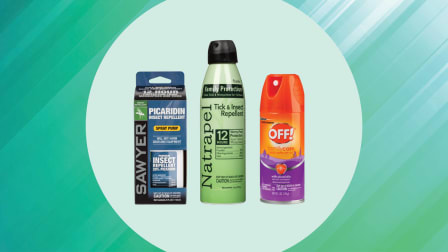How Safe Is Deet?
Despite assurances about the chemical, consumer concerns persist. Is there a reason to worry?

Over the years, one thing has become clear from Consumer Reports’ testing of insect repellents: When in doubt, go with deet. Repellents that use deet as an active ingredient make up the majority of our recommended products, and particularly at concentrations of 25 to 30 percent, deet-based repellents are remarkably consistent performers.
And it’s not just us. Scientists still consider deet to be the standard against which other, newer insect repellent active ingredients are judged.
Broad scientific consensus holds that the chemical is safe when used as directed on the label. Still, many consumers have reservations about using it. You may wonder: Is deet really safe? How do we know?
Here’s a rundown of what the research shows and what you need to know.
What Exactly Is Deet?
Deet (known to chemists as N,N-Diethyl-meta-toluamide) is a yellowish liquid that, when applied to skin or clothing, repels a number of biting insects, including mosquitoes, ticks, flies, and fleas. Deet doesn’t kill these bugs, but protects against them by keeping them from landing on your skin or clothes, or from biting if they do land.
Every year, an estimated one-third of the U.S. population uses deet-based products to fend off biting bugs like ticks and mosquitoes, according to the Environmental Protection Agency. Deet has been available to consumers since 1957, after being discovered by the U.S. military and the Department of Agriculture. Government scientists had tested thousands of chemicals; deet was one of a handful of mosquito repellents that worked.
Is Deet Safe?
The balance of evidence indicates that deet is safe when used as directed. There are a few things to keep in mind when considering reports to the contrary.
The overall incidence of deet poisoning is very low. In 1998, the Environmental Protection Agency conducted a definitive assessment of the chemical. The agency turned up 46 seizures and four deaths that were potentially linked to deet exposure. It estimated that since 1960, the incidence of seizures with a potential link to deet exposure was 1 per 100 million uses.
Most of those reported cases involved a misuse of deet products. Ingestion or “dermal application not consistent with label instructions” was the most common source of potential deet toxicity, according to the EPA. The agency concluded that when consumers followed product-label instructions and took reasonable precautions, the health risks of deet essentially vanished.
A vast majority of cases of deet toxicity are mild. In another seminal analysis, researchers looked at more than 9,000 deet-related calls made to poison control centers between 1985 and 1989. They found that almost 90 percent of the injuries were treated at home, and of those people referred to health centers, 80 percent were discharged after an examination. A second analysis of more than 20,000 calls made between 1993 and 1997 found similar results.
There is no reliable evidence that deet causes cancer. Neither the Department of Health and Human Services nor the EPA’s Office of Pesticide Programs has classified deet as a carcinogen. According to the Centers for Disease Control and Prevention, animal studies have not found an increase in tumors in research subjects who were given oral deet tablets or who had liquid deet applied to their skin. A Swedish study did find that men who used insect repellent for 115 days or longer faced an increased risk of developing testicular cancer. (A majority of repellents contained deet at the time of the study.) But the CDC says that the study was flawed and that the results were not conclusive.
Does Deet Pose Special Risks for Children?
It was this question that first triggered widespread deet-aversion among consumers. Between the early 1980s and late 1990s, 14 cases of potentially deet-related encephalopathy (brain damage) were reported in the medical literature, all but one of them in children who were 8 or younger. Three of those children died; the remaining 11 recovered fully.
The reports triggered a wave of fear among consumers that has yet to fully abate. But the link between the chemical and sickness was never conclusively proved, in part because not nearly enough information was reported for epidemiologists to discern between deet exposure and other potential causes (such as infections) in those cases.
That doesn’t mean there's no cause for caution. Any chemical poses some risk, especially when misused. But experts seem to agree that 14 is a vanishingly small number of incidents when compared with the estimated 100 million annual human applications of deet made during that same time period.
Other research indicates that contrary to conventional wisdom, children are no more susceptible to deet toxicity than adults. For example, the study that analyzed 20,000 poison control center calls (between 1993 and 1997) found that infants and children actually accounted for a greater proportion of cases with no or moderate effects, while adults accounted for a greater proportion of the cases with moderate and major effects.
Is Deet Safe for Pregnant Women?
It’s true that there are few published studies that focus on the effects of deet on pregnant women or their offspring, and almost none that examine deet usage during the first trimester when developing fetuses are most vulnerable.
It’s also true that there are some scary-sounding reports in both the research literature and the popular press. For example, at least one study found that when pregnant rats were exposed to high doses of deet, their offspring had low birth weights. At least three women who used deet during pregnancy gave birth to babies with severe birth defects, and at least one of those babies died.
But there are some important caveats to keep in mind when considering that information. First, the dose the rodents received was much higher than any normal human dose, and those findings about low birth weight were not replicated in other rat studies. In fact, similar animal studies found no effects from deet on pregnancy. Second, in the human cases, it’s very difficult to know whether deet was the true culprit.
The highest-quality research on deet in pregnant women is actually fairly reassuring.
Two separate studies—one in New Jersey (150 women) and one in Thailand (897 women)—found that while deet molecules can cross the placenta and enter the womb, they do so in very small concentrations. In both studies, babies born to mothers who used deet were not smaller or sicker and did not suffer from cognitive deficits or any major birth defects compared with babies born to mothers who did not use the chemical.
Is Deet Safe for the Environment?
For the most part, yes. Plenty of deet gets into the air when you spray it (especially if you’re using an aerosol). But according to the CDC, the chemical is broken down by sunlight and by other chemicals in the air. In 5 hours’ time, one-half of the deet released into the atmosphere will disappear this way.
The deet on your skin is most likely to end up in aquatic systems, because when you shower, bathe, or wash your clothing, the chemical slips from your skin and clothing into the water supply. In water, deet is degraded by aerobic microorganisms. In general, it does not stay in the environment for very long.

Tips for Safe Deet Use
As with all insect repellents, the key to using deet-based products safely is to follow product instructions and take basic precautions.
Use the right concentration. You don’t need 100 percent deet. Research shows that the concentration of active ingredient has an impact on how long the compound lasts, not on how well it works. Our testing indicates that products containing 25 to 30 percent deet typically provide at least several hours of protection. Any more than that and you’re increasing your exposure without improving the repellency.
Apply the repellent properly. Don’t spray it near your eyes or mouth. Instead, spray it on your hands, then rub it on your face. Don’t let young children apply repellent themselves. Also, repellent should be applied only to exposed skin, not to skin that will be covered by clothing. You can spray your clothing as well, especially if you’re going on a hike or plan to be out in mosquito- or tick-infested areas for a long stretch. The best way to do that is to spray the clothing on a hanger and let it dry before putting the clothes on. And just to be safe, you should wash the repellent off your skin when you come back indoors for the day or at the very least before bedtime.
Know when not to use it. There’s no hard-and-fast rule on what age it’s safe to use insect repellents on babies, but experts suggest using caution when considering them for infants. The CDC advises protecting babies that young by draping mosquito netting with elastic edges around their strollers or carriers.
Alternatives to Deet
If you’d still rather not use deet, there are other effective repellents to consider.
Picaridin
Picaridin is a repellent that was modeled after a molecule found in pepper plants. It has been on the U.S. market since 2005 and has done well in Consumer Reports’ tests. Specifically, spray products with at least 20 percent picaridin have worked as well as or better than some deet-based ones. Not as much research has been done on picaridin as on deet. But the data that does exist indicate that the chemical is safe, and the World Health Organization and the CDC recommend picaridin.
Oil of Lemon Eucalyptus (OLE)
Oil of lemon eucalyptus is another active ingredient that has done well in CR’s tests (especially at concentrations of 30 percent). OLE is registered with the EPA as a biopesticide, meaning that products containing this ingredient are subject to at least some testing for safety and efficacy. OLE is not recommended for children younger than 3; it has not been well studied in this group. But for everyone else, when used as directed, the CDC and EPA agree that it’s safe and works well.


















